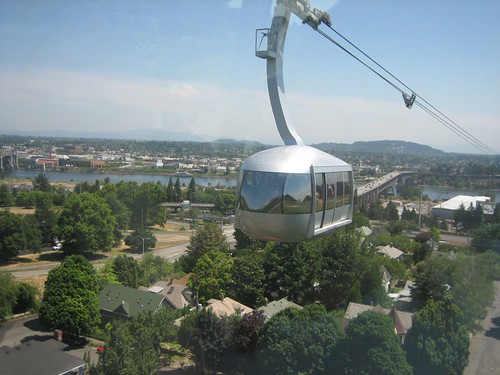but every city wants to be second.
The competitive drive to be number one just doesn’t seem to permeate City Hall and that’s understandable. Infrastructure is terribly expensive and no politician or planner wants to embarrass themselves by green-lighting a future white elephant.
Cities are therefore remarkably conservative when it comes to infrastructure. Cities tend only to adopt ideas and technologies that have already been proven in other locations, but sometimes even that strategy backfires:
The Portland Aerial Tram was the only Cable-Propelled Transit (CPT) system to be built for public transit purposes in North America since New York’s Roosevelt Island Tram was built in 1976.
Unfortunately, the Portland Tram’s planners took all their cues from New York and decided on using aerial tram technology; the most expensive of cable technologies and the one with the least upside.
There were several other cable technologies Portland could have and should have considered, but didn’t. Instead of being inquisitive, Portland simply did what New York did, seemingly unaware that New York’s choice of technology was due in part to the limited options the cable technology offered way back in 1976.
Playing Follow the Leader is fine when you’re in kindergarten, but when you’re all grown up you have to ask questions. Hard ones. And when you find answers, extrapolate from them and apply them to your own unique situation.
Images by William Beutler and CUP Projects



11 Comments
What other cable technology choice could Portland have made and why? Is it a cost mistake, or efficiency issue or capacity?
Wondering. Thanks.
Given the capacity and speed requirements of the system, an MDG system would’ve been a far more sound choice. It would’ve been far cheaper and would’ve resulted in much lower wait times.
Having said that, there are really only two potential reasons they may have opted for the Aerial Tram (note: this is pure speculation on my part as there is little in the way of publicly accessible information on the planning of the system):
a) They needed the higher wind stability the Aerial Tram offered. This doesn’t hold up to scrutiny, however, as a Funitel or 3S would’ve done the same trick – and both technologies were available at the time.
b) As they were flying over people’s homes, they may have wanted to minimize the number of vehicles. This is also somewhat suspect, however, as both the Funitel and 3S would’ve minimized those problems.
The shorter wait times is theoretically understandable as a benefit but the rider population at the PAT is very patient-centric, to include a large number of elderly and wheelchairs. Loading can take a while.
I also think Portland wanted to make a design statement in foster the iconic stature of the system over time. I think that played a large role in the choices made.
Thanks for the discussion. I have your site bookmarked and look forward to more posts. I dare you to write a few sentences about what you like about the PAT. ; )
That’s an interesting perspective and one I hadn’t considered. At the same time, all systems are fully-accessible and easy for people to board and aligt.
As per your dare: I like that Portland was bold with this project. It’s architecturally stunning and isn’t just a ski lift ported into a city. That’s something we often try to get people to work towards. At the same time, the price point was WAY out of control for what it was.
It came in at around $57m at the time. Now compare that to the recently-opened Cabrio in Stans, Switzerland. All in, the Cabrio came in at $23m CHF and is more than double the length of the PAT.
Again, valid points. I think it is agreed that circumstances conspired to increase costs to a level not fully anticipated. The Cabrio is quite a people mover. I was not aware it was done at such a reasonable cost for the distance covered. Is that the principal metric used for budgetary efficiency when it comes to tramways generally?